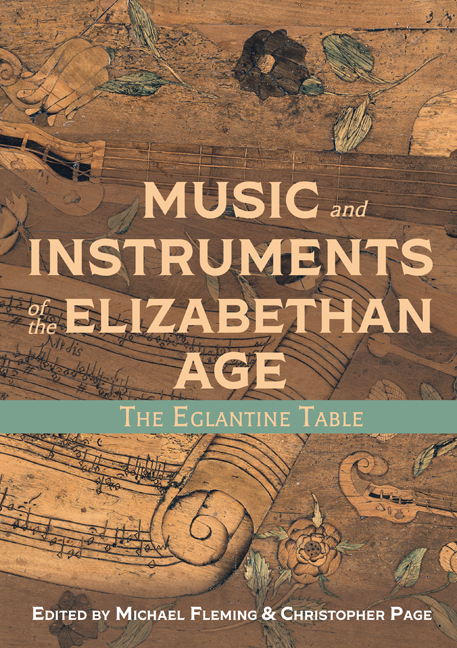Book contents
- Frontmatter
- Dedication
- Contents
- List of Illustrations
- Foreword
- Acknowledgements
- Note to the Reader
- List of Abbreviations
- Introducing the Eglantine Table
- Part I Silent Things
- Part II Music and Instruments
- Part III Broader Views of the Eglantine Table
- Appendices
- Glossary
- Bibliography
- List of Contributors
- Index
- Plate section
Introducing the Eglantine Table
Published online by Cambridge University Press: 24 March 2021
- Frontmatter
- Dedication
- Contents
- List of Illustrations
- Foreword
- Acknowledgements
- Note to the Reader
- List of Abbreviations
- Introducing the Eglantine Table
- Part I Silent Things
- Part II Music and Instruments
- Part III Broader Views of the Eglantine Table
- Appendices
- Glossary
- Bibliography
- List of Contributors
- Index
- Plate section
Summary
In the reign of Queen Elizabeth I (1558–1603), an experience of music among the great could be much more than an experience of sound. There was a space, perhaps a familiar one and opulent, with textiles, grotesquerie and heraldic panels to entice the eye and complement what was heard, for musical sound also has a surface. There was company, some attentive, some perhaps thinking of the board games that might follow, arrayed in garments that a practised gaze could interpret in terms of power and dependency. There were musicians, who might be the salaried members of a liveried group, their music intangible in performance but perhaps given material substance with pen, ink and paper – things that had a mystique of their own in an age when even the great found writing a high and formal craft. Finally, there were musical instruments: shapely, fragile and often temperamental by modern standards, the more expensive of them using inlay and exotic imported woods. Their sounds, timbres and varied repertoires evoked the indoor pleasures of the hall, chamber and tavern, or the diversions of the festive year at church ales and other ceremonies, as the seasonal flowers and fruits appeared in their annual round.
The Table and its context
The Eglantine Table, probably made during the late 1560s and now to be seen at Hardwick Hall in Derbyshire, conveys an exceptional sense of music as a variegated experience. It is 900 mm high, 3,020 mm long and 1,290 mm wide, and its entire upper surface is decorated with marquetry and inlay images depicting fifteen contemporary musical instruments, often in exquisite detail, open books and scrolls of music with legible musical notation, gaming boards, writing implements, heraldic beasts and flowers (Figure A and Plate 2). The surface also shows the arms of Elizabeth, Countess of Shrewsbury (1527?–1608), commonly known today as Bess of Hardwick. As the various biographies devoted to her reveal, Bess has been admired down the centuries for her shrewdness, her capacity for self-directed action during four marriages to powerful men, and her lavish expenditure on buildings. In 1552 she and her second husband, Sir William Cavendish, began to create a great house at Chatsworth, in the valley of the Derwent, which Bess completed in 1580 during her marriage to her last spouse George Talbot, 6th Earl of Shrewsbury (c1522–1590).
- Type
- Chapter
- Information
- Music and Instruments of the Elizabethan AgeThe Eglantine Table, pp. 1 - 18Publisher: Boydell & BrewerPrint publication year: 2021



